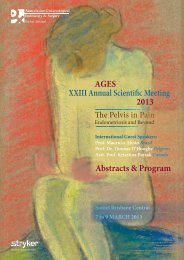to Obstetric Trauma Pelvic Floor Repair Surgical Essentials - AGES
to Obstetric Trauma Pelvic Floor Repair Surgical Essentials - AGES
to Obstetric Trauma Pelvic Floor Repair Surgical Essentials - AGES
Create successful ePaper yourself
Turn your PDF publications into a flip-book with our unique Google optimized e-Paper software.
Free<br />
Communications<br />
Session 7B 7A<br />
Saturday<br />
4 June<br />
at that time. For these women sacrocolpopexy may have been a<br />
better initial procedure, although one has <strong>to</strong> consider that fac<strong>to</strong>rs<br />
such as previous surgery or obesity may have led surgeons <strong>to</strong> favour<br />
a vaginal approach. However, it appears that a sacrocolpopexy is<br />
more difficult after a vaginal mesh repair than beforehand.<br />
AUTHOR AFFILIATION: J. Short; Oxford Clinic Christchurch and<br />
Christchurch Women’s Hospital Christchurch, New Zealand.<br />
Session 7 - Free Communications A<br />
1440-1450<br />
Outcomes of surgical revision of<br />
synthetic slings for pos<strong>to</strong>perative<br />
pain and/or sling extrusion<br />
Agnew G, Dwyer PL, Rosamilia A, Edwards G, Lee JK<br />
INTRODUCTION: Synthetic slings (SS) are now the most common<br />
treatment for female stress urinary incontinence (SUI). <strong>Surgical</strong><br />
revision of the SS may be necessary <strong>to</strong> treat pos<strong>to</strong>perative pain and/<br />
or extrusion of the SS material. The aim of this study was <strong>to</strong> identify<br />
the types of SS implicated in this complication and evaluate the<br />
subsequent functional outcomes such as recurrent SUI following<br />
revision surgery.<br />
METHODS: We conducted a retrospective review of all women<br />
who underwent revision of a SS at our unit between 2000 and<br />
2010 inclusive, for the indication of pain and/or extrusion of the<br />
sling material. The extent of surgical revision was at the surgeon’s<br />
discretion, but in all cases consisted of at least partial excision of SS<br />
material.<br />
RESULTS: Forty five women underwent revision for pain/sling<br />
extrusion during the study period. The mean interval between SS<br />
insertion and its surgical revision was 28.2 months ranging from<br />
2 weeks <strong>to</strong> 17 years. <strong>Surgical</strong> revision, in all cases, consisted of at<br />
least partial excision of the sling material. Twenty three women had<br />
their SS partly excised and 22 had a complete removal of the SS<br />
material. Eleven slings were classified as infected on removal, 10<br />
of these, were multifilament slings. Thirty nine women (39/45) had<br />
their SS revised for detectable extrusion of the sling material. Six<br />
women (6/45) had their SS revised for the indication of pain, without<br />
any detectable extrusion. Three of these slings were found <strong>to</strong> be<br />
infected on removal, IVS ® (2) and Lynx ® (1). The other three were<br />
transobtura<strong>to</strong>r slings; Monarc ® (2) and TVT-O ® (1). Subsequent<br />
<strong>to</strong> revision, pain resolved in all patients. Of the 45 women, 9/45<br />
(20%), underwent a concomitant procedure <strong>to</strong> prevent recurrent<br />
SUI at the time of their revision procedure. Thirty six (80%) had<br />
no concomitant procedure at the time of SS revision. None of the<br />
concomitant group, but 11(36%) of the non concomitant group,<br />
subsequently required further surgery for recurrent SUI (0% [0/9]<br />
vs. 31% [11/36]; p = 0.056).<br />
CONCLUSIONS: SS procedures for SUI may result in complications<br />
many years distant from the initial placement. If SS revision<br />
comprises excision of sling material, then a concomitant procedure<br />
<strong>to</strong> prevent recurrent SUI should be considered, provided infection<br />
is not suspected. Synthetic slings of a multifilament type are more<br />
strongly associated with infection and are not recommended.<br />
AUTHOR AFFILIATION: G. Agnew 1 , P. L. Dwyer 1 , A. Rosamilia 2 , G.<br />
Edwards 2 , J. K. Lee 1,2 ;<br />
1.Department of Urogynaecology, Mercy Hospital for Women<br />
2.Monash Medical Centre Melbourne, Vic<strong>to</strong>ria, Australia.<br />
Session 7 - Free Communications A<br />
1450-1500<br />
Pilot study <strong>to</strong> compare barbed and<br />
conventional sutures for fixation<br />
of the anterior vaginal portion of<br />
mesh in laparoscopic sacrocolpopexy<br />
Aust T, Chou D, Cario G, Rosen D, Reyftmann L, Fleming T, Ber<strong>to</strong>llo<br />
N, Walsh W<br />
Bidirectional and unidirectional barbed sutures have recently<br />
been used for laparoscopic gynaecological procedures such as<br />
myomec<strong>to</strong>my and hysterec<strong>to</strong>my. They are also being used by some<br />
<strong>to</strong> attach mesh <strong>to</strong> the anterior vaginal wall <strong>to</strong> reduce operative time<br />
and <strong>to</strong> avoid laparoscopic knotting. We wished <strong>to</strong> examine whether<br />
these sutures would provide the same strength as conventional<br />
suturing using a reconstruction and testing the maximum tensions<br />
that could be applied.<br />
Connective tissue was obtained from the abdominal walls of sheep<br />
euthanized from other experiments. 2cm width strips of the tissue<br />
acted as the internal surface of the vagina stripped of peri<strong>to</strong>neum.<br />
2cm width strips of polypropylene mesh were then sutured <strong>to</strong> the<br />
tissue in a laparoscopic trainer <strong>to</strong> reproduce the conditions of a<br />
laparoscopic sacrocolpopexy.<br />
Comparisons are planned between Quill bidirectional barbed suture,<br />
V-Loc unidirectional barbed suture and intracorporeally knotted PDS<br />
21

















